AMD's New Year Refresh: Athlon II X4 635, Phenom II X2 555, Athlon II X2 255 & Athlon II X3 440
by Anand Lal Shimpi on January 25, 2010 12:00 AM EST- Posted in
- CPUs
AMD is looking a lot more competitive in 2010 than I expected just a few months ago. Intel finally unveiled Clarkdale and thanks to the high cost of Core i5 ownership AMD hasn't really been threatened. The Core i3 530 is the biggest threat, but it only competes with one member of AMD's lineup at $113.
Thanks to continued improvements in Global Foundries' 45nm process, AMD is delivering slight clock bumps for its dual, triple and quad-core processors while dropping prices of others. This is what AMD is launching today:
| Processor | Clock Speed | L2 Cache | L3 Cache | TDP | Price |
| AMD Phenom II X4 910e | 2.6GHz | 2MB | 6MB | 65W | $169 |
| AMD Phenom II X2 555 BE | 3.2GHz | 1MB | 6MB | 80W | $99 |
| AMD Athlon II X4 635 | 2.9GHz | 2MB | 0MB | 95W | $119 |
| AMD Athlon II X3 440 | 3.0GHz | 1.5MB | 0MB | 95W | $84 |
| AMD Athlon II X2 255 | 3.1GHz | 2MB | 0MB | 65W | $74 |
It's nothing revolutionary. AMD already delivers good value below $130 and today's launch just improves upon that. What you won't see here is anything on AMD's 8-series chipsets, due out in the March - May timeframe.
| AMD 790GX | AMD 890GX | |
| CPU | AMD Socket-AM3 | AMD Socket-AM3 |
| Manufacturing Process | 55nm | ?? |
| PCI Express | 22 PCIe 2.0 lanes | ?? |
| Graphics | Radeon HD 3300 (DirectX 10.0) | DirectX 10.1 integrated GPU |
| Core Clock | 700MHz | 700MHz |
| Shader Processors | 8 (5-way) | ?? |
| Full H.264/VC-1/MPEG-2 HW Decode | Yes (UVD) | Yes (UVD2) |
| 8-channel LPCM | No | Yes |
| USB | 12 USB 2.0 ports | 14 USB 2.0 ports |
| SATA | 6 SATA 3Gbps ports | 6 SATA 6Gbps ports |
You also won't see anything about the new Thuban or Zosma cores, AMD's high end 6-core and 4-core products for 2010. We know model numbers but we don't know clock speeds, features or prices. Expect to see them in late Q2.
| Processor | Cores | Clock Speed | L2 Cache | L3 Cache | TDP | Price |
| AMD Phenom II X6 1075T | 6 | ?? | ?? | 6MB | 125W | ?? |
| AMD Phenom II X6 1055T | 6 | ?? | ?? | 6MB | 125W/95W | ?? |
| AMD Phenom II X6 1035T | 6 | ?? | ?? | 6MB | 95W | ?? |
| AMD Phenom II X4 960T | 4 | ?? | ?? | 6MB | 95W | ?? |
The Phenom II X4 910e - 65W Quad-Core
I'll start with the least interesting first. The Phenom II X4 910e brings us a 65W full-blown Phenom II quad-core at 2.6GHz. You pay a hefty premium for the lower voltage part; $169 normally buys you 3GHz in the Phenom II X4 lineup.
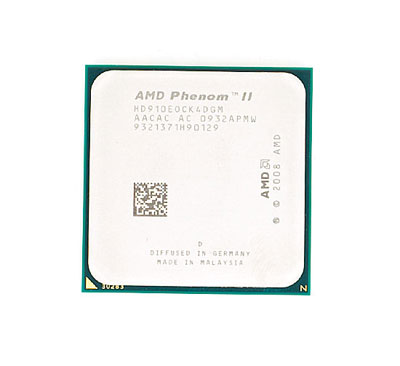
The power savings are measurable though, here we have the 910e at idle and under full load compared to a 125W Phenom II X4 965BE and the rest of today's lineup:
| Processor | TDP | Total System Idle Power | Total System Load Power (x264 Encode) |
| AMD Phenom II X4 965 BE | 125W | 89.7W | 174W |
| AMD Phenom II X4 910e | 65W | 84.6W | 134W |
| AMD Phenom II X2 555 BE | 80W | 82.3W | 161W |
| AMD Athlon II X4 635 | 95W | 79.5W | 157W |
| AMD Athlon II X2 255 | 65W | 76.3W | 130W |
Idle power improves a bit vs. the 125W quad-cores, but load power is respectable. The 2.6GHz quad-core 910e draws only 4 more watts than a dual core Athlon II running at 3.1GHz. You pay handsomely for the lower power consumption, but if you're an OEM looking for such a thing without undervolting a standard 125W processor it could be worth it.
The Phenom II X2 555 BE - AMD's Fastest Dual-Core
Remember the Phenom II X2 550 BE? That was a quad-core Phenom II with two cores disabled, but a full 6MB L3 cache. It was a beast of a dual-core CPU but AMD quietly pulled it off its price list months ago. You could still find the chips in retail and priced quite effectivley at $99, but the Core i3 530 manages to offer better performance at nearly the same price.
AMD's response? The Phenom II X2 555 BE. Still an unlocked Black Edition part, the 555 pushes its clock speed up to 3.2GHz. The extra 100MHz won't do much for performance but the price remains at $99. The problem with the Phenom II X2's architecture is that you get relatively small and high latency L2 caches (512KB, 15 cycle) and a large/high latency L3 cache (6MB, ~40 - 50 cycles). It's not ideal for a dual-core chip.With Clarkdale you at least get much lower latency caches (10 cycles and sub-40 cycles for L2 and L3 respectively).
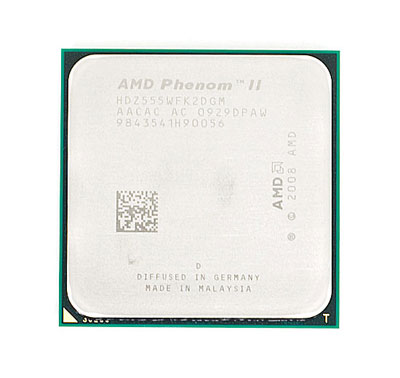
I'm not particularly excited about the Phenom II X2 555 BE, but AMD has sweetened the deal a bit. This chip now supports hardware C1E, like the first Athlon IIs. And no, I haven't encountered any CnQ bugs with it.
The hardware C1E means lower idle power consumption (I explained it in greater detail here) and it's courtesy of the new C3 Phenom II stepping. A side effect of this newer silicon rev is that it should overclock better. Our old Phenom II X2 550 BE hit 3.5 - 3.6GHz on air at stock voltage, and our new chip did 3.8GHz in the same conditions:
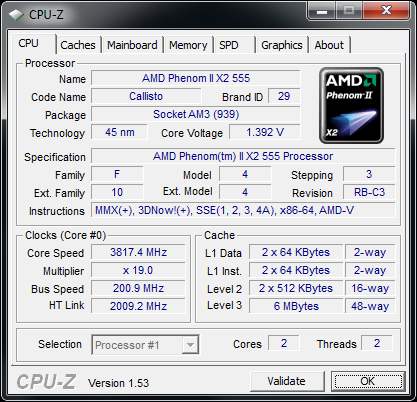
Part of the success of our chip here is due to its nearly 1.4V default voltage. Lower default voltages may only see 3.6GHz without going any further. Pushing beyond 3.8GHz proved to be very difficult on air, at least with any amount of stability under Windows 7 64-bit.
The Athlon II X4 630 & 635 - Even More Affordable Quad-Core
For a thread-junkie, you can't beat the Athlon II X4. You get more cores for $99 than Intel would dream of selling and today AMD is making it even more affordable. The Athlon II X4 630 drops from $122 to $99, and the new 635 enters at $119. The 635 doesn't give you much, just an extra 100MHz for $20 more.
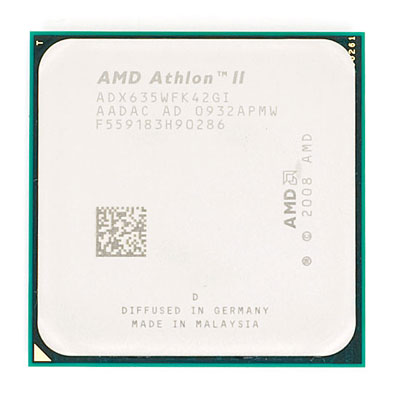
The 620 was my pick for 3D rendering/video encoding on a budget. Now with the price drop, the 630 is the chip to get. The 635 isn't really worth the added dough at stock clock speeds. If you're going to be overclocking though, the news is good.
I got my Athlon II X4 635 up to 3.5GHz without any additional voltage, this is an improvement over the first Athlon II X4s I received. Back in September the best I could do was ~3.3GHz.
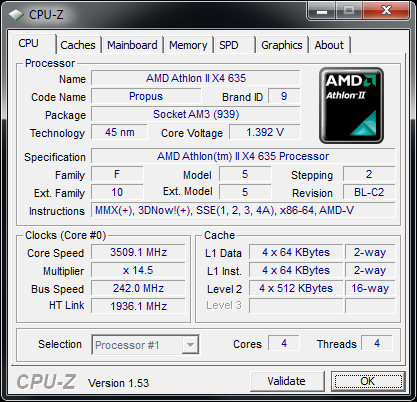
More than anything these new chips are examples of good old fashioned process technology improvements. Yields improve with time (at least they should for a company interested in being profitable) and with that comes improved overclockability over time.
The Athlon II X3 440 & Athlon II X2 255 - Value Speed Bump
The Athlon II X3 440 will set you back $84 and gives you three cores running at 3.0GHz. The best Intel will give you is a pair of cores running at 3.06GHz sharing a 2MB L2 cache - the Pentium E6600. You get more cache per core, but fewer cores than the Athlon II X3. It's the same story as the Core i3 vs. Athlon II X4. If you need more threads, go AMD, if you run lightly threaded apps you'll be faster with Intel at these price points. Interestingly enough, below $100 AMD actually offers more threads per dollar than Intel.

If you want a more even match there's the Athlon II X2 255. At $74 you get a pair of 3.1GHz cores with a 1MB L2 per core. Our 255 hit 3.6GHz without any additional voltage, but with some effort you can be in the 3.7 - 3.8GHz range.
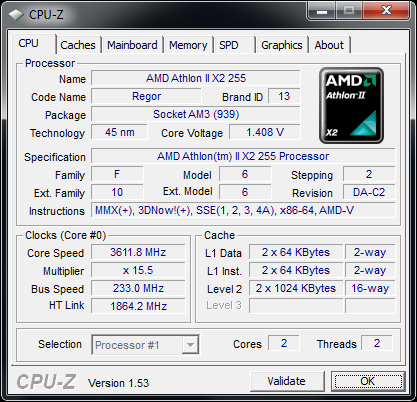










63 Comments
View All Comments
mindless1 - Saturday, January 30, 2010 - link
Not necessarily, some e-series run any given frequency at a lower voltage, so by the same token whatever a non-e can do undervolted, an e- might do a bit higher speed at same voltage.Further, not all boards allow undervolting much, if at all, especially when you're trying to build a very small system. Big system with full mATX or ATX board with full o'c features, and silent fans is something just about any Tom, Dick, and Harry can build with no need to pick an e-series or undervolt a regular CPU.
play2learn - Monday, January 25, 2010 - link
Not everybody have up to date CPU:s. Anand, it would be fun if you sneak in an old processor like pentium 3, 4 or Pentium D next time.Taft12 - Wednesday, January 27, 2010 - link
Anand did just that back in when Phenom II X2 and Athlon II X2 were released:http://www.anandtech.com/cpuchipsets/showdoc.aspx?...">http://www.anandtech.com/cpuchipsets/showdoc.aspx?...
It was an embarrassment, no self-respecting hardware geek should be using that crap when the cheapest CPU and motherboard on the market today buries that stone-age technology.
mindless1 - Saturday, January 30, 2010 - link
... but to many geeks, it's the love of tech, not the ePenis you claim by virtue of your system performance.I mean really, there is a point where even a geek takes a sensible position about what is appropriate for the work or play they actually do. Would you be amazed to know I still have a Celeron 500MHz fileserver running? The geek in me made it right in the first place including beefed up mobo capacitors, very open heatsink that takes years to get appreciable dust in it, filtered intake/positive pressure, and a few others things faster, but inferior for the purpose, systems have today.
mindless1 - Saturday, January 30, 2010 - link
lol, meant ... DON'T usually have today.play2learn - Thursday, January 28, 2010 - link
You have a point there. But then there are people like me that's still not satisfied with today's technology and just sit and wait and wait for that ultimate experience to show up. If you want me to buy a new system today (which is not going to happen) I need to be humiliated more than once.ssj4Gogeta - Monday, January 25, 2010 - link
Won't it skew the graphs (eg. a bar too long to fit or a bar too small to be visible)NJoy - Monday, January 25, 2010 - link
Sure it would. Last week just out of curiosity I decided to run CinebenchR10 on a Dell Precision with dual Xeons (PD 3Ghz based, 4 threads) against C2D E8400. Guest what? Over 4 minutes for Xeons whilst about 2:20 for C2D. Humiliation...mattscottshea - Monday, January 25, 2010 - link
These are assumptions made by current naming standards. However, if these were to hold true, it would be quite a coup by AMD as there current unreleased top of the line 975 will run at 3.6GHz with 4 cores at 140W using the C3 stepping.AMD Phenom II X6 1075T 3.6GHz 6 cores / 125W (D1 stepping?)
AMD Phenom II X6 1055T 3.2GHz 6 cores / 95W
AMD Phenom II X6 1035T 2.9GHz 6 cores / 95W
AMD Phenom II X4 960T 3.3GHz 4 cores / 95W
MrSpadge - Monday, January 25, 2010 - link
LOL. Naming conventions are there to lure people into buying just when you break the convention (*looking at the greenteam*)Anyway, their process has not magically changed - otherwise todays CPUs would be more energy efficient. And a new stepping is not going to turn the world upside down.. maybe a gain of 5% power at similar settings and a slightly higher clock speed at similar power levels.
And today you're getting 4 cores at 3.4 GHz for 140 / 125W. They'll be lucky and need heavy speed binning to get 3 GHz at 140W for the best 6-core CPU.